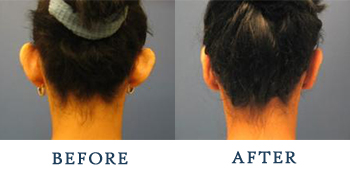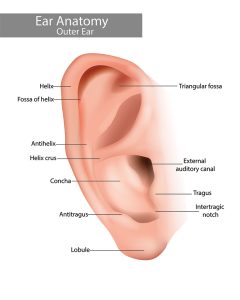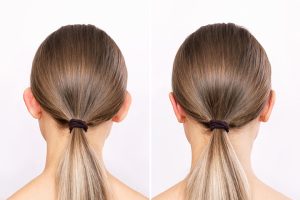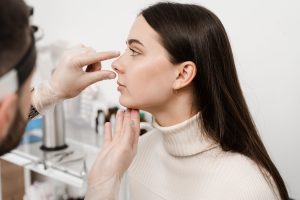Also Serving Ear Surgery Patients in Everett & Bellingham
Ear surgery or otoplasty can dramatically improve the appearance of your ears, whether you are concerned with prominent ears, misshapen ears, or an ear injury.
At Cascade Facial Surgery, Dr. Jonathan Grant treats every patient as an individual. All ears are unique, so your surgery must also be unique. Your surgical plan is designed specifically to provide you with the result you want within the parameters of sound and safe medical practices.
Dr. Grant’s training and experience as a reconstructive facial surgeon especially comes into play during ear surgery, as the process may involve reshaping the cartilage of the ear.
Who is a candidate for Ear Surgery?
Candidates for ear surgery include adults and children (usually over the age of five) who dislike the look of their ears, including issues such as:
- Prominent ears that stick out from the face
- Misshapen ears
- Injuries to the earlobes, including piercing injuries, such as torn earlobes, or stretched out earlobes from gauge piercing
- Ears that are too large
- Ears that do not match in size or shape
- Earlobes that have stretched and increased in size
Understanding the Ear Surgery Procedure
Dr. Grant will examine you during your consultation and discuss what you dislike about your ears. Then, he can devise a surgical plan for you.
The surgery is an outpatient procedure that can sometimes be performed using IV anesthetic and sedation, while some patients may require general anesthesia. Children are recommended to have surgery using general anesthesia. You (and your child, where applicable) will be able to go home on the same day as the surgery. Some adults are candidates for having the procedure done with local anesthetic alone.
For prominent ears that stick out from the head, the procedure is sometimes called “ear pinning.” This involves permanent sutures that hold the backs of the ears closer to the head.
For reshaping of the ears, cartilage may have to be removed. In some cases, cartilage may be taken from one part of the ear and grafted to another area. If there is not enough cartilage available from the ears, it can be harvested from the ribs in rare cases (from the patient or a donor). If this is necessary, Dr. Grant will discuss it with you before your surgery.
If the earlobes have been stretched, a portion is usually excised to make them smaller. In the case of torn ear piercings, the hole is sutured for a smaller opening, or it can be completely closed if the patient prefers.
Whatever methods Dr. Grant uses, the goal is to make your ears look as normal as possible.

Recovering From Ear Surgery
You can expect to need a week off from work or school after ear surgery, although for more complex cases, more downtime may be necessary. The ears will be bandaged for a weekday and night, then at night only for another three to five weeks.
Ear buds cannot be used as they heal. Please avoid sports and exercise for three to six weeks. It is very important that the ears not suffer any injuries, such as being hit by a ball, during the healing period.
After all surgeries, there is some pain and swelling. Some patients also experience some mild bruising. These symptoms are to be expected.
You can take pain medication, and we will give you instructions how to take care of your ears during this time. Sleeping upright or with your head elevated for the first few nights will help to keep swelling to a minimum. It is important not to sleep on your sides for a week or two.
Note that swelling is the last symptom to resolve. While the ears will look better immediately, it may take months for the last bit of swelling to go down. Most of our patients remark that the recovery period is quite easy and well worth the results.
Ear Surgery Costs
Since each ear surgery that Dr. Grant performs is customized to the needs of the specific patient, the price can vary significantly. After assessing your ears during a consultation, Dr. Grant can devise a surgical treatment and provide a quote that reflects the types of changes he will make. Although otoplasty is not likely to be covered by your medical insurance, Cascade Facial Surgery & Aesthetics accepts financing options through CareCredit so that you can make payments toward the total cost of the surgery.
Learn More
If you are interested in ear surgery in the Western Washington area, contact us to find out if you’re a good candidate for the procedure.
Contact Us Today!Common Questions About Ear Surgery
 What is the recovery timeline for ear surgery?
What is the recovery timeline for ear surgery?
Otoplasty is a delicate procedure, and while the surgery itself is typically completed in just a few hours, the recovery process takes time. Below is a general recovery timeline, highlighting key milestones:
Week 1:
In the first week, you will experience some discomfort, swelling, and bruising around the ears. A protective bandage will be worn to help maintain the new ear position and promote healing. Pain is typically manageable with prescribed medications, and most patients return to light activities after about three to five days. Children should take extra care to avoid physical activities during this time.
Week 2:
By the second week, most of the bruising and swelling will have significantly reduced. Stitches (if not dissolvable) may be removed, and patients often switch to a lighter headband for additional protection, especially while sleeping. Many adults can return to work or school at this stage, though strenuous physical activities should still be avoided.
Weeks 3-4:
As healing progresses, any residual swelling will continue to subside. Most patients feel comfortable resuming normal daily activities, including exercise, after the third or fourth week. It is essential to follow your surgeon’s instructions to ensure optimal healing and results.
Months 2-6:
After two months, the final shape and positioning of the ears will become more apparent. Over the following months, the appearance will continue to improve as the tissue heals completely. Adults generally heal slightly faster than children, but both groups should expect a full recovery by six months.
Can ear surgery correct asymmetrical ears, and how common is this condition?
Yes, otoplasty can address asymmetrical ears, a common condition among children and adults.
What is the typical age range for children undergoing otoplasty?
Children typically undergo otoplasty between ages 5 and 7, once their ears have developed sufficiently.
How can I ensure my ears will look natural post-surgery?
Choosing an experienced surgeon, such as Dr. Grant, ensures that your ears will look natural and proportionate to your face.
Should I adjust my lifestyle before surgery?
Before surgery, avoid smoking and limit alcohol intake to support optimal healing. You may also be advised to stop taking certain medications that affect blood clotting.
What are the long-term effects of ear surgery?
Otoplasty results are permanent, meaning patients will enjoy the benefits of their enhanced ear appearance for life. For children who undergo surgery at a young age, their results will last well into adulthood. It’s important to follow post-operative care instructions to ensure lasting success. In rare cases where revision surgery may be needed, Dr. Grant can correct any concerns stemming from previous procedures.
Ready to Transform Your Appearance?
If you’re considering ear surgery for yourself or your child, Dr. Grant at Cascade Face in Mt. Vernon is here to guide you through the process. With a commitment to delivering natural, long-lasting results, Dr. Grant helps patients enhance their appearance and boost their confidence. Contact us today to schedule your consultation and learn more about how otoplasty can benefit you or your loved one.
Ear Surgery FAQs
What causes the ears to protrude on some people?
 Usually, a prominent ear sticks out because the fold of the antihelix is underdeveloped, which causes the helix to extend outward rather than inward toward the head. Some people also have overdeveloped cartilage in the ear, which can make it more prominent.
Usually, a prominent ear sticks out because the fold of the antihelix is underdeveloped, which causes the helix to extend outward rather than inward toward the head. Some people also have overdeveloped cartilage in the ear, which can make it more prominent.
Will my hearing be affected by ear surgery?
Otoplasty does not improve or worsen your hearing; if you are concerned about your hearing, you should consult with an audiologist to find an appropriate treatment. Ear surgery focuses on the cosmetic appearance of the ears, usually pinning the ears closer to the head.
Why do so many children have otoplasty?
In most cases, people with prominent ears have them from birth, so they choose to seek surgery sooner than later. Some specifically want surgery to avoid bullying that often affects kids with prominent ears. Dr. Grant prefers that his patients be around ten years old at the earliest because by that age their ears are (practically) fully developed and adult sized. Moreover, the patients are better able to participate in their own care and understand aftercare issues such as not picking scabs or rubbing their ears.
Is there an advantage to waiting until adulthood to have otoplasty?
There is no advantage per se, but it is not uncommon for people to have ear surgery once they are an adult. Some have parents that did not support having the surgery when they were kids. Some feel that the “cute” look of having prominent ears does not correspond with their maturing face. Some have spent their lives hiding their ears beneath their hair and no longer want to be constrained in that way.
Should I expect scarring after ear surgery?
Because ear surgery requires incisions, some scarring is inevitable. The good news is that the incisions are placed either behind the ear or inside the ear so that the scarring is almost impossible to spot. Better yet, these scars fade significantly with time.
How long will my ear surgery results last?
 While some types of plastic surgery need to be repeated periodically to maintain the results, ear surgery is considered permanent. Even for children, the results should last a lifetime.
While some types of plastic surgery need to be repeated periodically to maintain the results, ear surgery is considered permanent. Even for children, the results should last a lifetime.
Can I re-pierce my ears after having lobe repair?
Yes, after repairing a torn lobe or removing a hole from a gauge piercing, you can pierce your ears once again. However, Dr. Grant encourages you to wait at least two months so that your lobe has sufficient time to heal before piercing it again. Keep in mind that Dr. Grant can often leave a slight hole in the lobe so that re-piercing the lobe may not even be necessary if you would like to resume wearing earrings again.

 What is the recovery timeline for ear surgery?
What is the recovery timeline for ear surgery?





